Wood kitchen flooring ideas – experts share their top tips for choosing a hardwearing but stylish floor
The best wood kitchen flooring ideas will bring warmth, texture, and style to your home – as well as being a practical and long wearing choice
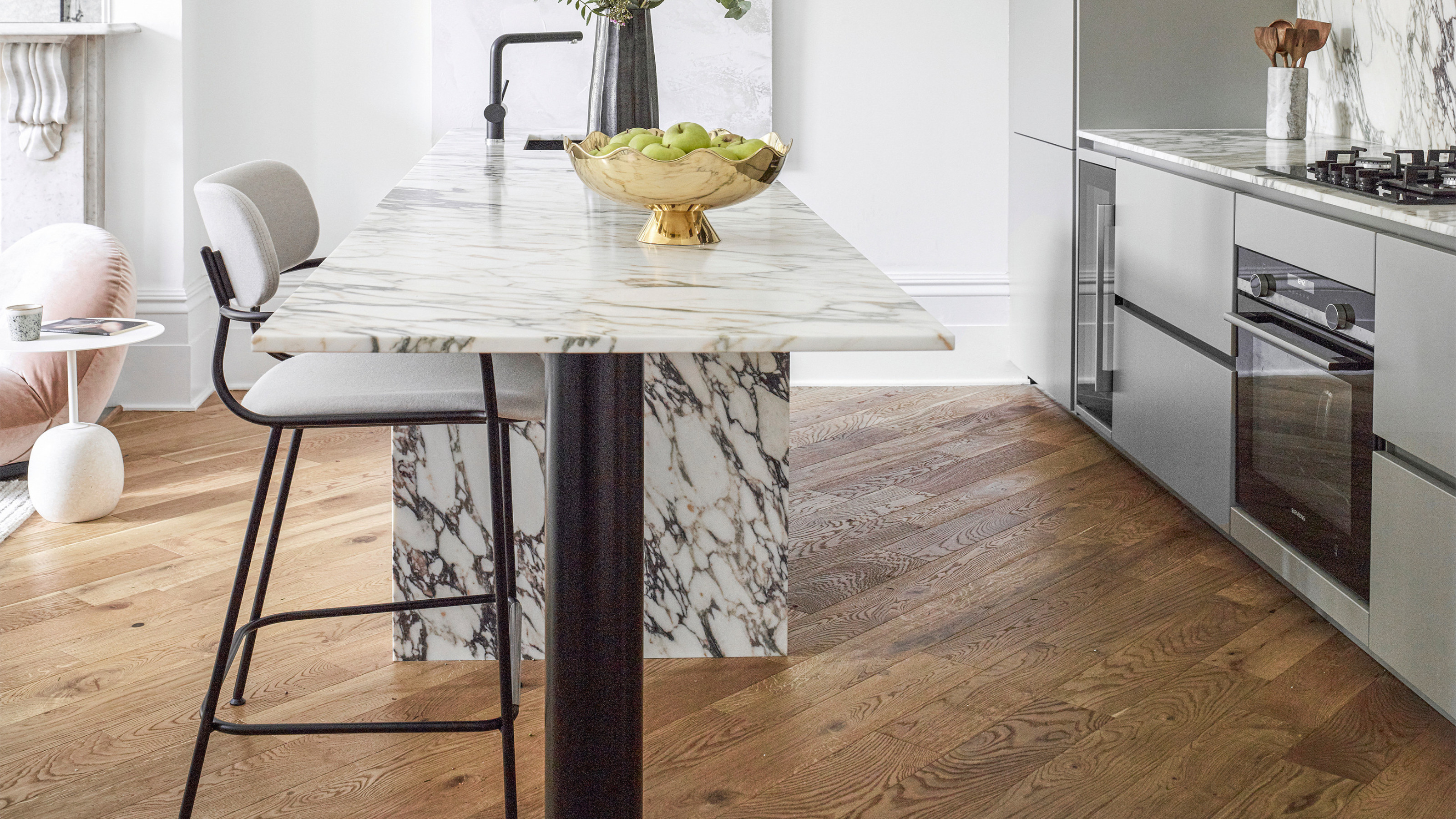

Looking for wood kitchen flooring ideas? You're not alone. Wooden floors have been - and continue to be - an incredibly popular choice throughout the whole house, let alone the kitchen.
It's easy to see why; they're warm, easy to clean, can be a very sustainable option and they look gorgeous. They can feel old and they can feel new depending on the style you go for, while the color and grain variety is almost endless. But is it the right choice for your space?
Experts reveal why they think wooden kitchen floors make an excellent choice along with some key things to consider when picking timber, from real hardwood and engineered wood to chevron and herringbone designs.
Choosing a kitchen floor is an important part of the overall scheme and can really alter how a kitchen space looks and feels so compare a variety of different kitchen flooring ideas before you get started and see which material works best for you.
Wood kitchen flooring ideas and expert advice
1. Solid or engineered wood kitchen flooring?
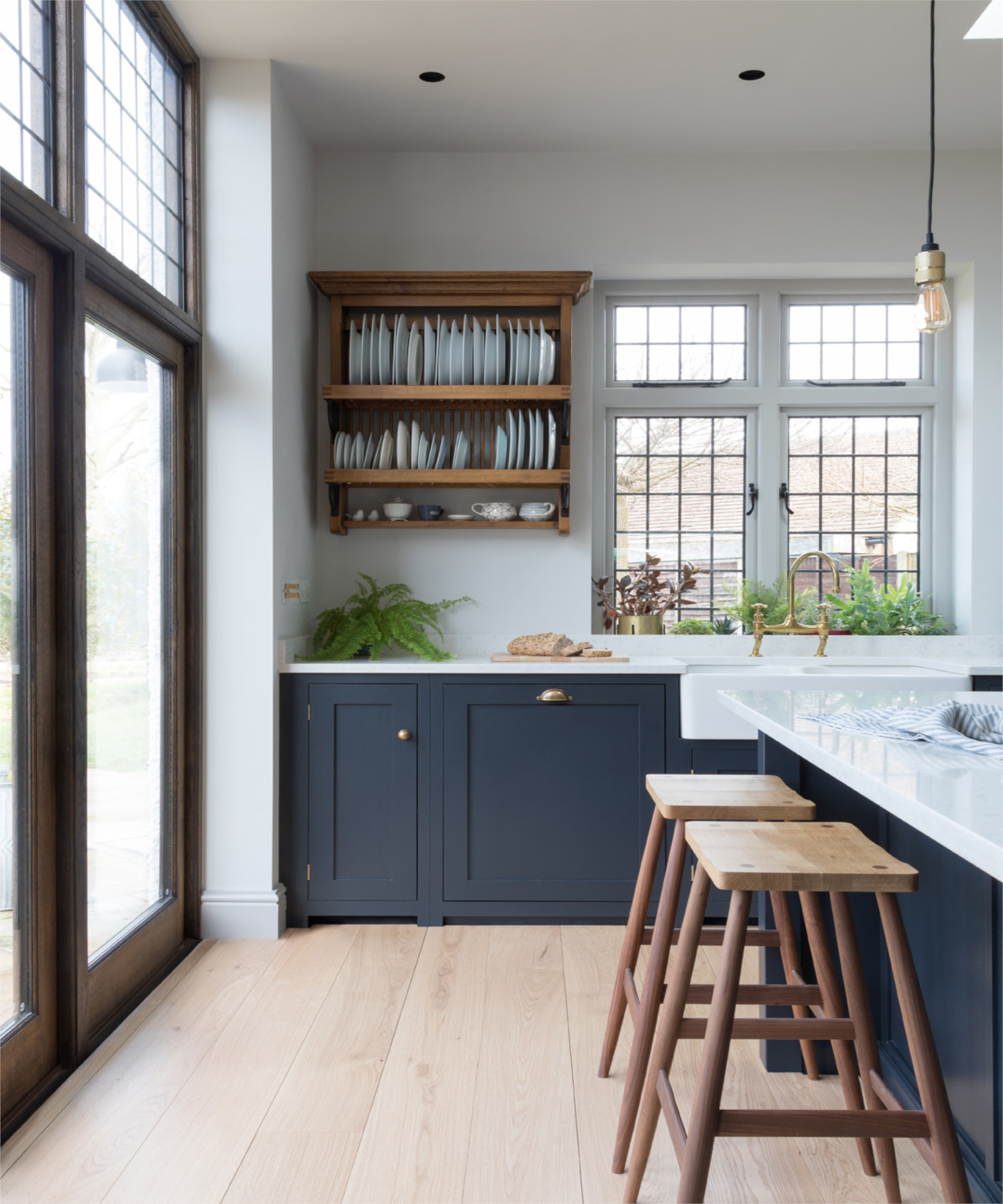
Wood flooring is a popular kitchen idea because it's a natural resource that's durable, warm underfoot and has a natural beauty to it. Solid wood floors, whether reclaimed wood or brand new, can look absolutely stunning, but there's a setback; they can potentially warp over time in high moisture areas.
Kitchen floors are faced with all kinds of spills so if you prefer a very polished look it's worth noting that real wooden floors can end up looking bumped and bruised over the years, but that can look gorgeous if you're after a more relaxed aesthetic. A matte wood finish tends to be more forgiving, but be prepared to embrace some character if a solid wood floor is what you're after.
Engineered wood flooring could be a more practical solution, where just the top layer is solid hardwood and it sits on top of a plywood base. 'With all the timeless character and warmth of a solid wood floor, engineered wood can be sanded down and refinished over time, offering longevity and the opportunity to create a new look,' says Peter Keane, Director of The Natural Wood Floor Company.
'While it can be tempting to be led by price with a wood-effect option such as laminate, investing that little bit extra and opting for engineered or real wood flooring instead will give you many advantages and be more cost-effective in the long-term.'
Peter's view is that in the kitchen, engineered rather than solid hardwood flooring is best. 'This is because engineered wood flooring is able to withstand changes in temperature, humidity, and moisture, because of the way it is constructed. The top layer of the plank is real wood, while underneath these layers of plywood give it dimensional strength and stability. Layering wood in this way also reduces the wood’s natural tendency to expand and contract, meaning it is perfect to lay over underfloor heating and to use in areas like kitchens.'
2. What's the difference between engineered wood flooring, solid wood flooring and wood-effect laminate?
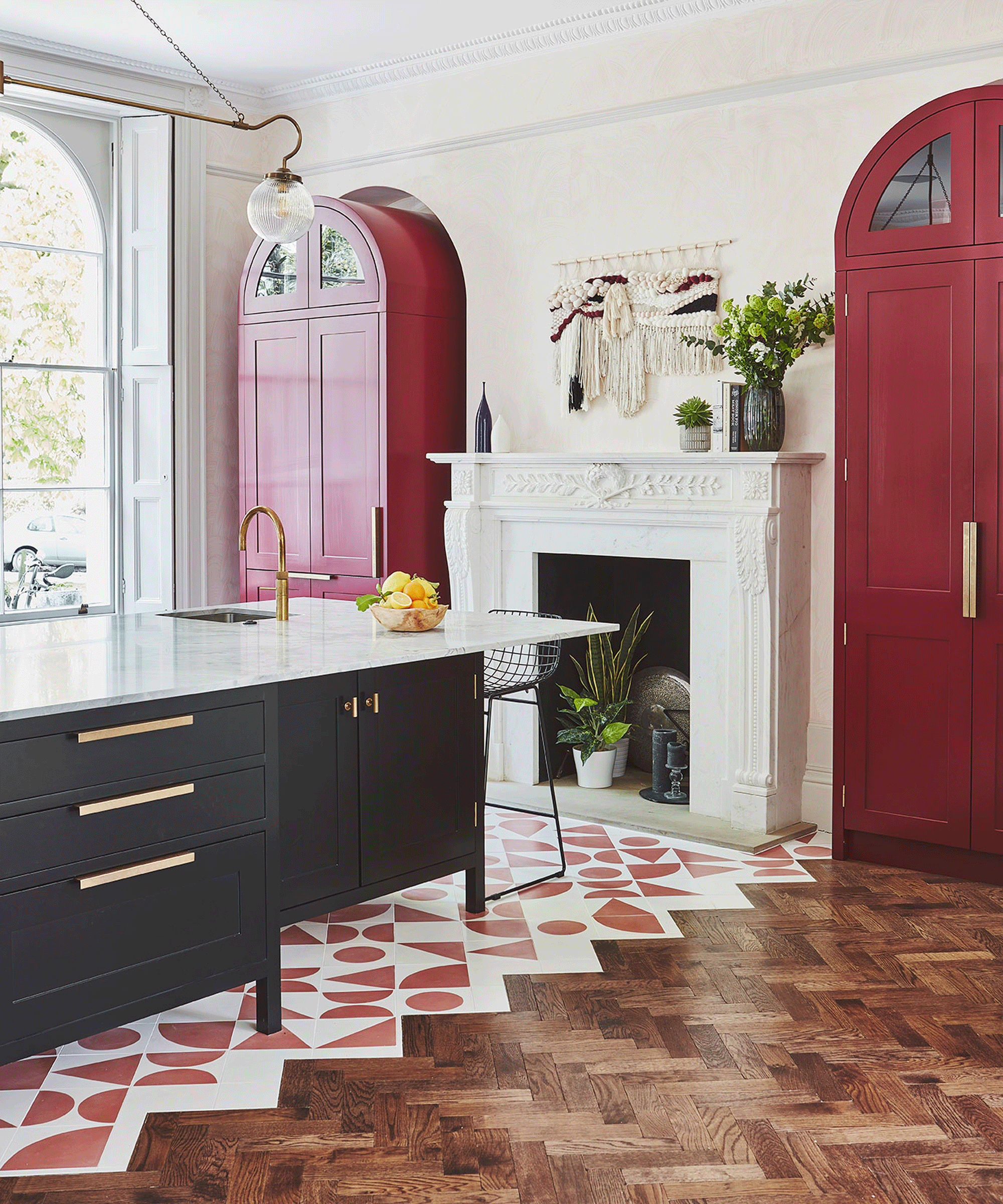
On appearance alone, these two very different types of wood flooring ideas can seem almost identical. They're both 'real' wood, but with engineered wood, it's just the top layer that's solid hardwood. But how does real wood compare to engineered wood for kitchen flooring?
'Wood flooring is warm underfoot, acoustically comforting, and lends itself perfectly to modern and traditional kitchens alike. Wood floors are one of the cornerstones of any interior and are versatile enough to adapt to any scheme. Go for the best quality you can – flooring underpins everything, and it is not as easy to change as other elements in a room,' says Robert Walsh, Founder and Owner, Ted Todd. 'Once installed, it is often almost impossible to tell solid and engineered floors apart,'
'The main difference is the way the planks of flooring are constructed. Engineered flooring is precision made from layered sections of solid wood bonded together. In engineered wood, the grain of each piece runs in a different direction to its adjacent layer. This enhances the plank’s strength and resilience and reduces the wood’s natural tendency to expand and contract – which means it’s perfect with underfloor heating or in areas like the cellar, basements or conservatories where moisture and temperature levels may vary.'
'Engineered wood flooring options, unlike solid or stripped wooden floors, do not need to be nailed or glued to the sub-floor,' he continues. 'It’s important to never confuse engineered boards with laminate or veneer. Engineered hardwood flooring uses a 4mm-6mm hardwood layer, giving a hard-wearing finish that will last for decades, laminate has an image of wood printed on its surface whilst veneer uses only a very thin layer of wood over a core of some type of composite wood product, usually fibreboard.'
3. How to take care of real wood kitchen flooring
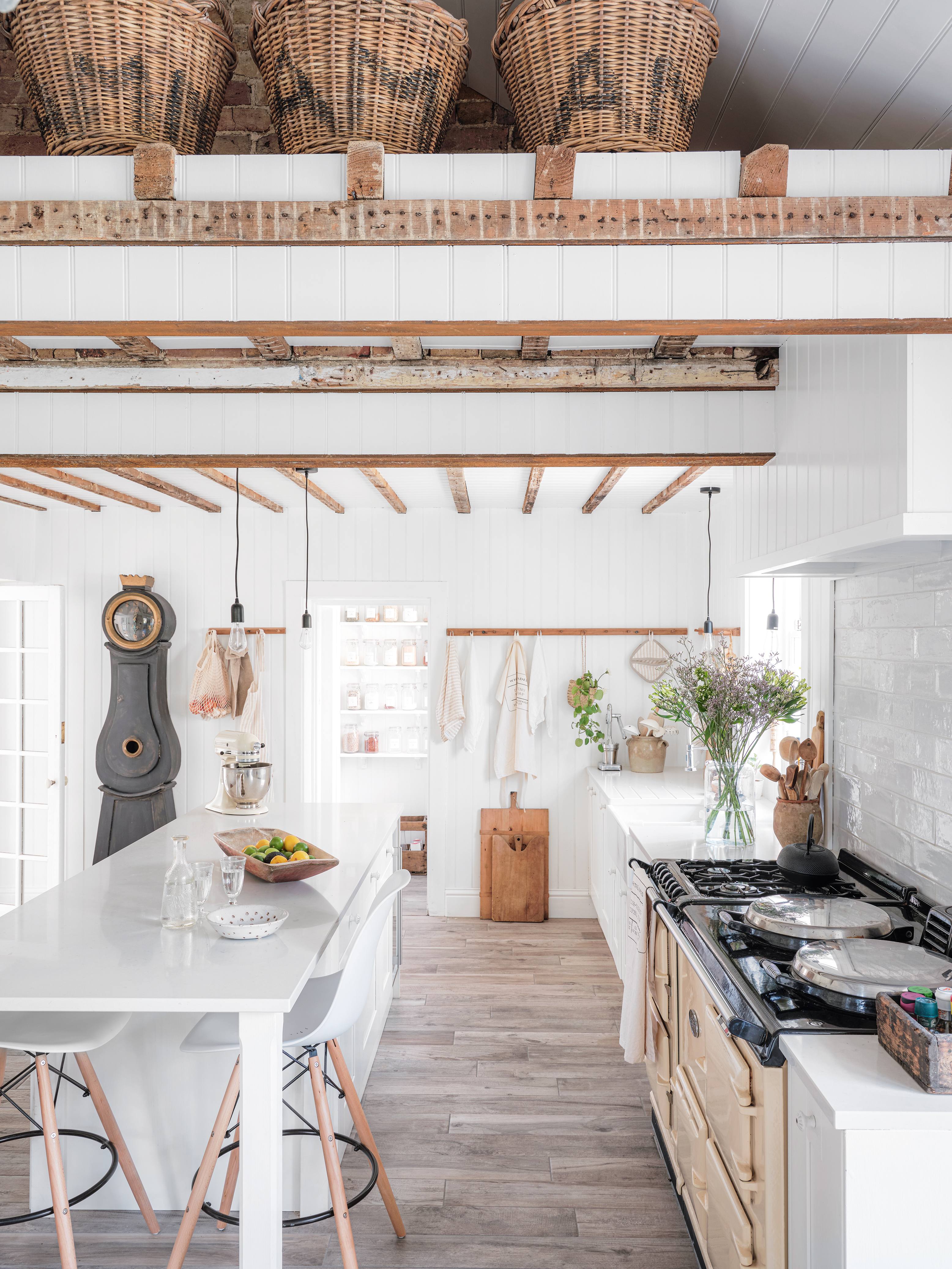
Why are wood floors a good choice for modern kitchens? Well, they not only add warmth and character to a room, but wood is one of the most resilient, hard-wearing, and natural flooring coverings, far outlasting alternatives such as vinyl and laminate. Wood ages beautifully and if properly cared for, will last a lifetime.
'We would always recommend taking good care of your flooring, especially in the kitchen where spills and high moisture levels are more likely.' says Robert Walsh, Founder, and Owner, of Ted Todd. 'A combination of regular sweeping to reduce the amount of debris on the surface of the floor and specialist hardwood floor cleaners to provide a deeper clean, will normally keep wood in top condition. To mop up spillages we’d suggest using a rag or paper towel to soak up the bulk of the liquid and recommend using a Ted Todd care kit to clean up afterwards. If your floor is finished with a hardened coating such as hardened oil, matt lacquer, satin lacquer, or naked skin lacquer, you’ll need care system one. For floors with an oil based finish such as restoration oil or burnished hardwax oil, you’ll need care system two.'
'Always talk to a flooring professional before fitting to get the best advice on which floors will work best in your kitchen,' he adds.
4. What style of wood kitchen flooring is best?
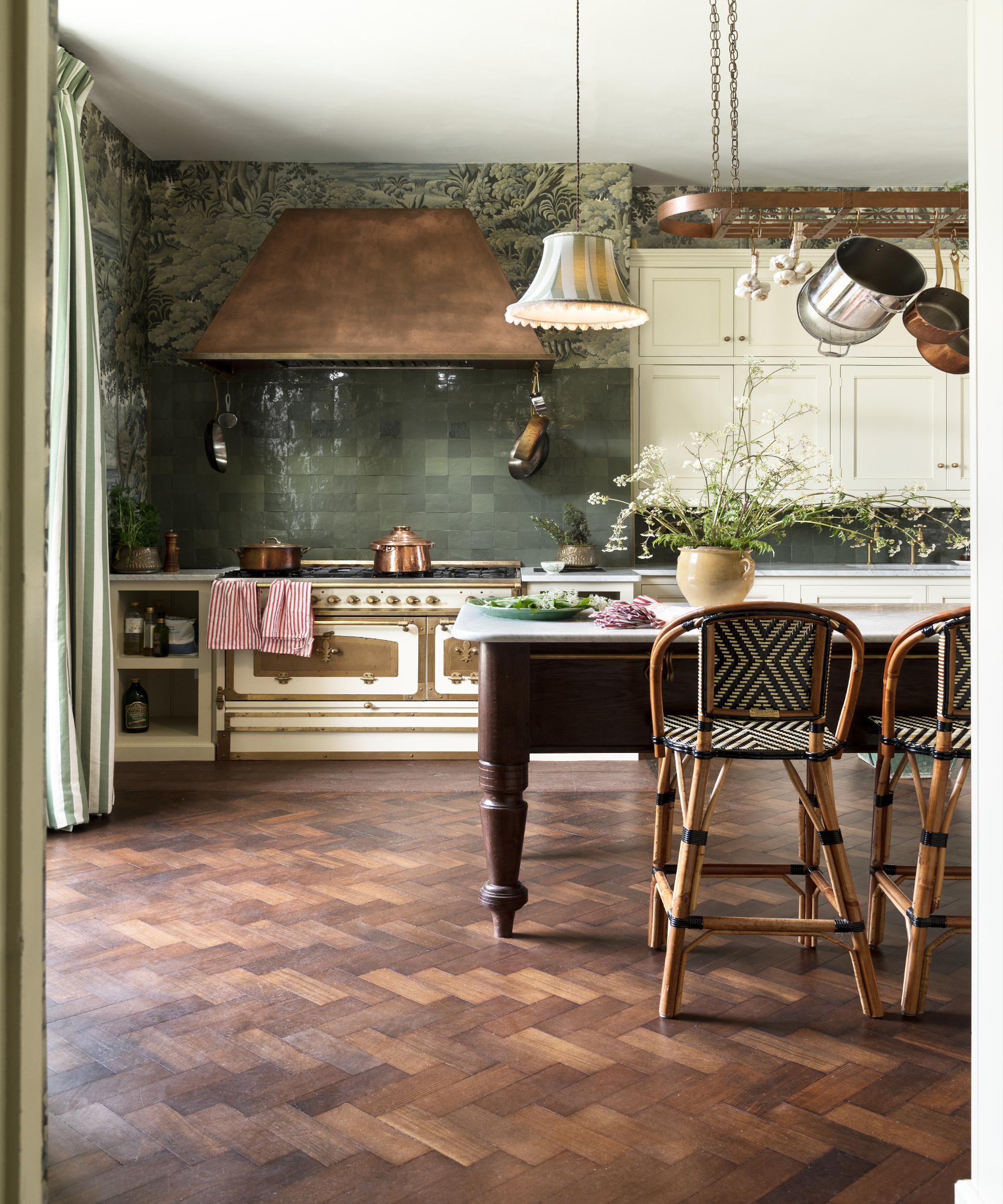
There really isn’t a right or wrong answer in terms of best wooden flooring designs and styles as it's all down to personal taste. Whether plank, herringbone, chevron or the very best parquet flooring; they're all designs that lend themselves perfectly for installation in a kitchen according to Robert Walsh.
'The spatial plan for the floor is always the starting point. The first questions that always need to be asked are ‘which areas will the floor run through?’ and ‘what is the size and shape of the space?’. This will help you to get the structure right,' he explains. 'The most important part of an interior is the structure and not the decoration and a good wood floor defines the structure.'
Once you have got the structure right you can look at the aesthetic of the floor. From different patterns to varying colors and tones, wooden floors provide so much choice and will suit both modern and more classic schemes.
'We're noticing espresso stained oak flooring to be popular in many of our recent projects,' says Sara Cukerbaum, Principal of Austin-based interior design studio SLIC Design. 'It's a return to something a bit richer that offers more depth to our spaces.'
5. Opt for pattern wood flooring with herringbone or chevron
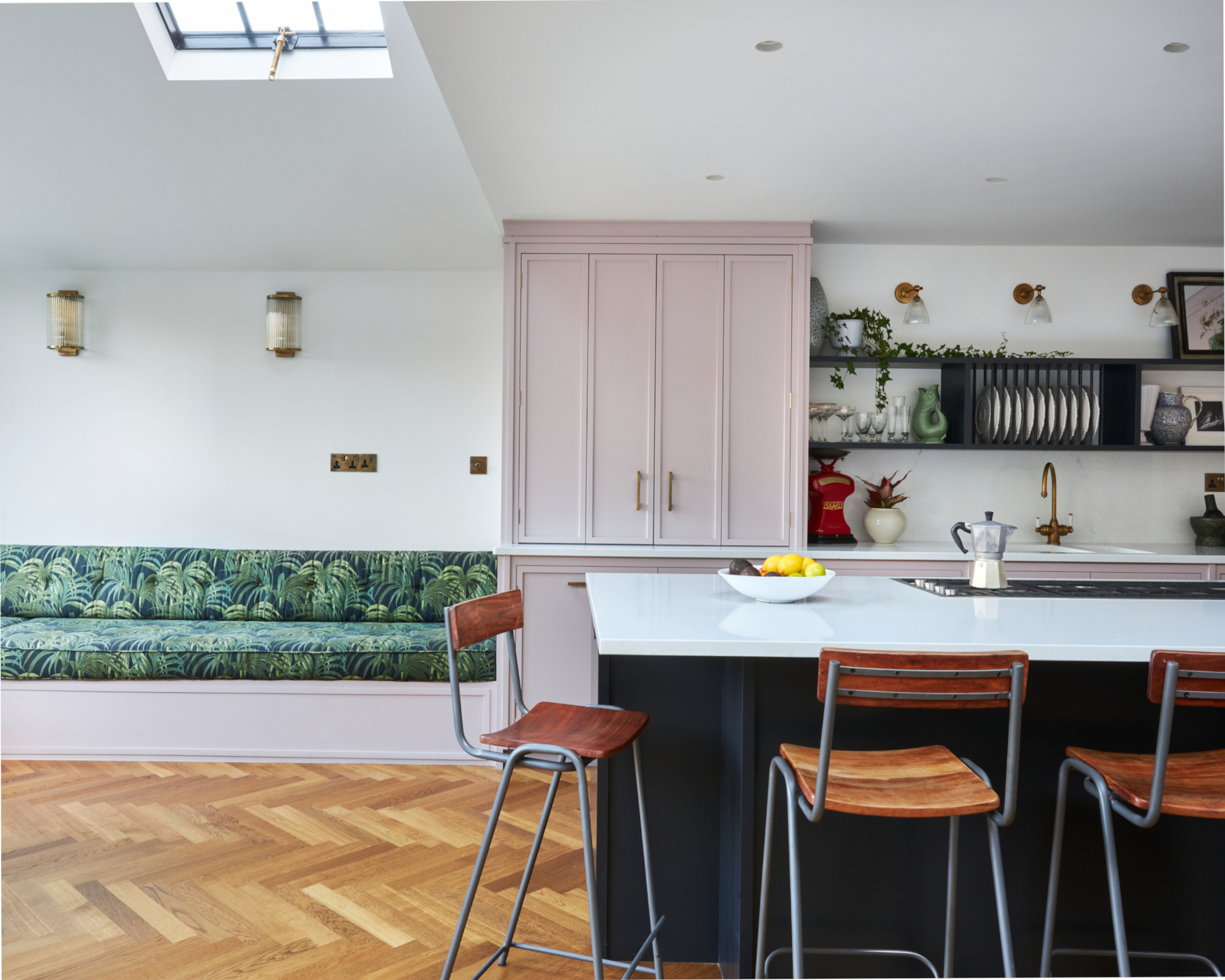
What's the difference between herringbone, chevron, and parquet exactly? Put simply, herringbone and chevron are two styles of parquet flooring, which can also include other geometrical patterns such as triangles and squares. William Durrant, Owner of Herringbone Kitchens says 'flooring trends are something that can completely alter the appearance of a space a lot more than people give credit for.'
Chevron flooring is a design style that consists of alternating straight and diagonal stripes matching up at the same point and is recognizable through its “V” pattern, whereas herringbone has its wood strips laid using complete rectangular blocks or planks in an alternating direction. The resulting pattern looks like the spine of a herring fish.
'Herringbone wood floors are a classic pattern that work well in both modern and traditional homes. We recently installed white oak herringbone floors in a modern home to add some texture and dimension,' says Sara Cukerbaum, Principal of Austin-based interior design studio SLIC Design. 'We are currently working on a project where we are using ebony-stained oak in a herringbone pattern in their entry. It's a beautiful way to bring something classic to a modern space.'
According to Robert Walsh, there are several benefits to playing around with wooden patterns; 'running a herringbone through an L-shaped kitchen can make a difficult space into a feature while narrow boards in a small space make them feel bigger. Plus, longer boards in a long room extenuate the space,' he adds. 'Patterns can bring together many small rooms into a single space and mixing different woods in different formats can create the feeling that the interior has evolved overtime.'
6. Real wood kitchen floors are durable and easy to keep clean
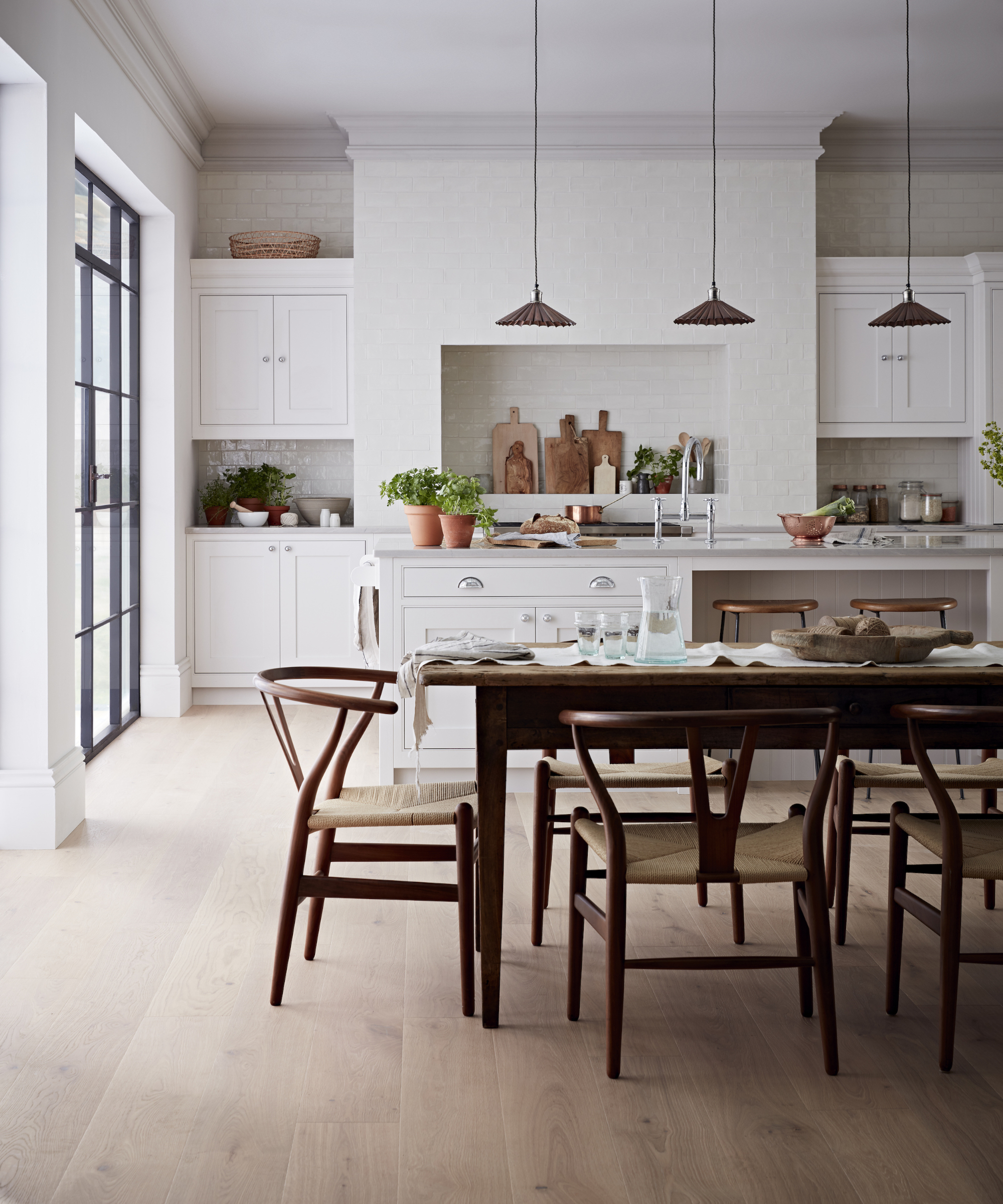
'There’s nothing quite like a real oak floor and with woods natural antibacterial properties, a clean kitchen space is totally achievable.' say the experts at Atkinson & Kirby. 'Oak can add warmth and coziness to any space. A brushed and oiled finish allows the floor to breathe, creating a robust and durable floor that is easy to maintain.'
Peter Keane, Director of The Natural Wood Floor Company adds that 'perhaps the best news for family homes is that wood flooring is very easy to keep clean. Muddy footprints and spillages are taken care of easily with a gentle mop and some mild detergent and unlike laminate, an engineered wood floor can be sanded down and refinished numerous times over its lifespan.'
7. Real wood kitchen flooring is a sustainable option

Sustainability continues to be at the forefront of people’s minds with more and more people making eco-conscious decisions, like eco flooring, when it comes to redesigning their homes and interiors.
'The Biophilic interior design trend continues on into 2022, meaning that natural and rustic textures will still be a key trend in flooring. Herringbone and parquet patterns are also super stylish in kitchens and not going anywhere just yet!' say the experts at Harvey Maria. 'Harvey Maria MSeries authentic wood planks are recognized for their low impact on the environment in all aspects – production process, product composition, emissions & indoor air quality and sustainable construction.'
8. Real wood floors help us connect with nature
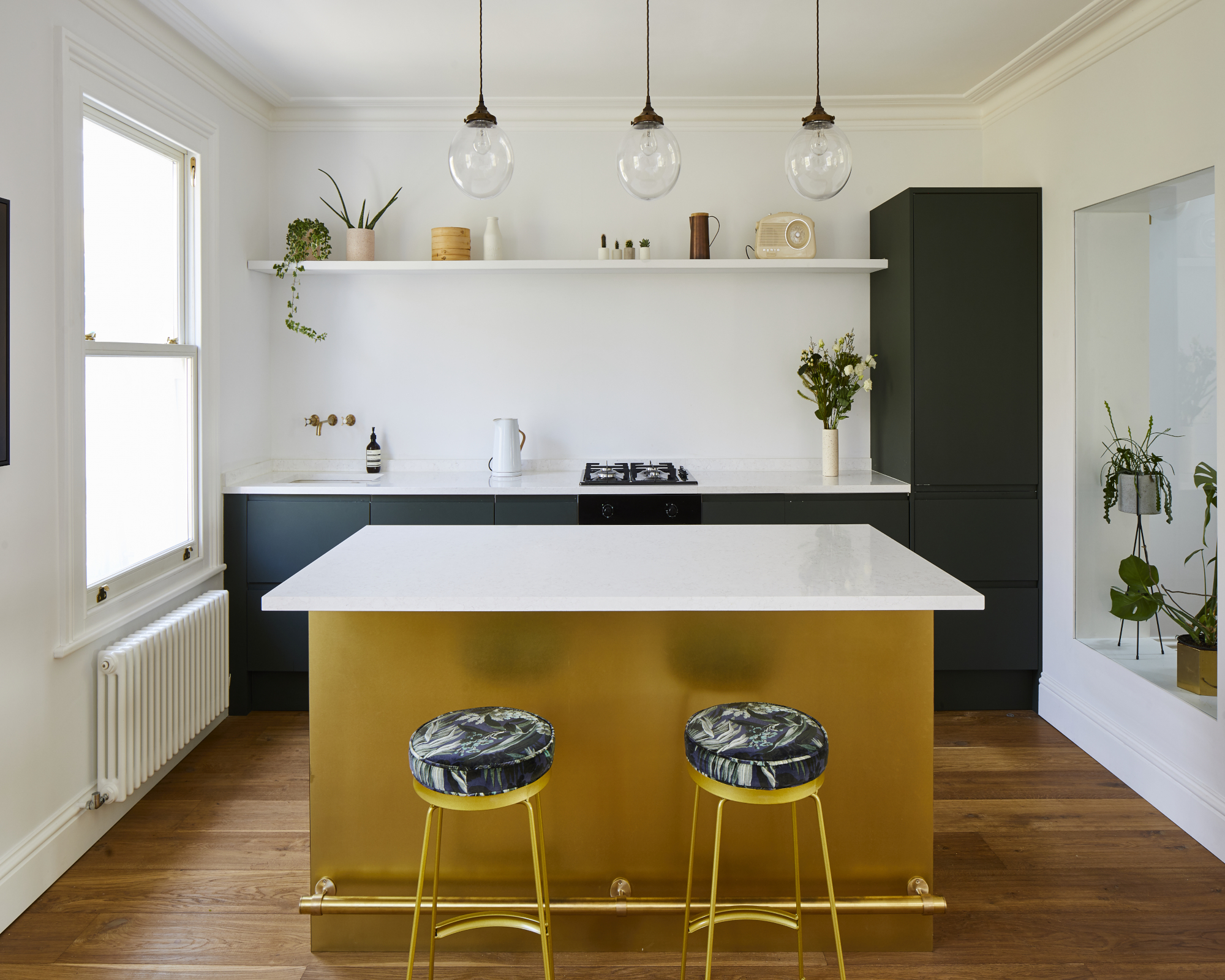
Connecting with nature is something more of us crave as we spend so much time behind desks or perched on our sofas. One easy way is by bringing the outside in and making our interiors feel more natural with materials such as wood, stone, cork and marble decorating ideas.
'Spending so much time indoors has certainly shown us how important our surroundings are. Bringing elements of nature inside the house is one of the key factors when deciding on interiors,' says Yolande Meyer, Purchasing Manager, Havwoods. 'Bringing wood inside the home lets one resonate with nature as the natural wooden hues have a calming and relaxing effect on the mind.'
'Flooring with plenty of character is becoming extremely popular. While prime grading has been the favorite for some time, we are seeing more consumers opting for boards with added character,' she adds. 'As planks with character grading will have more knots and traditional wooden characteristics such as visual cracks and sapwood. The ‘Nature’ trend comes to mind with character boards, as it allows one to feel more in line with nature by being able to see the knots and the grains of the wood.'
9. Choose wood-effect tiles for a more minimalist flooring solution
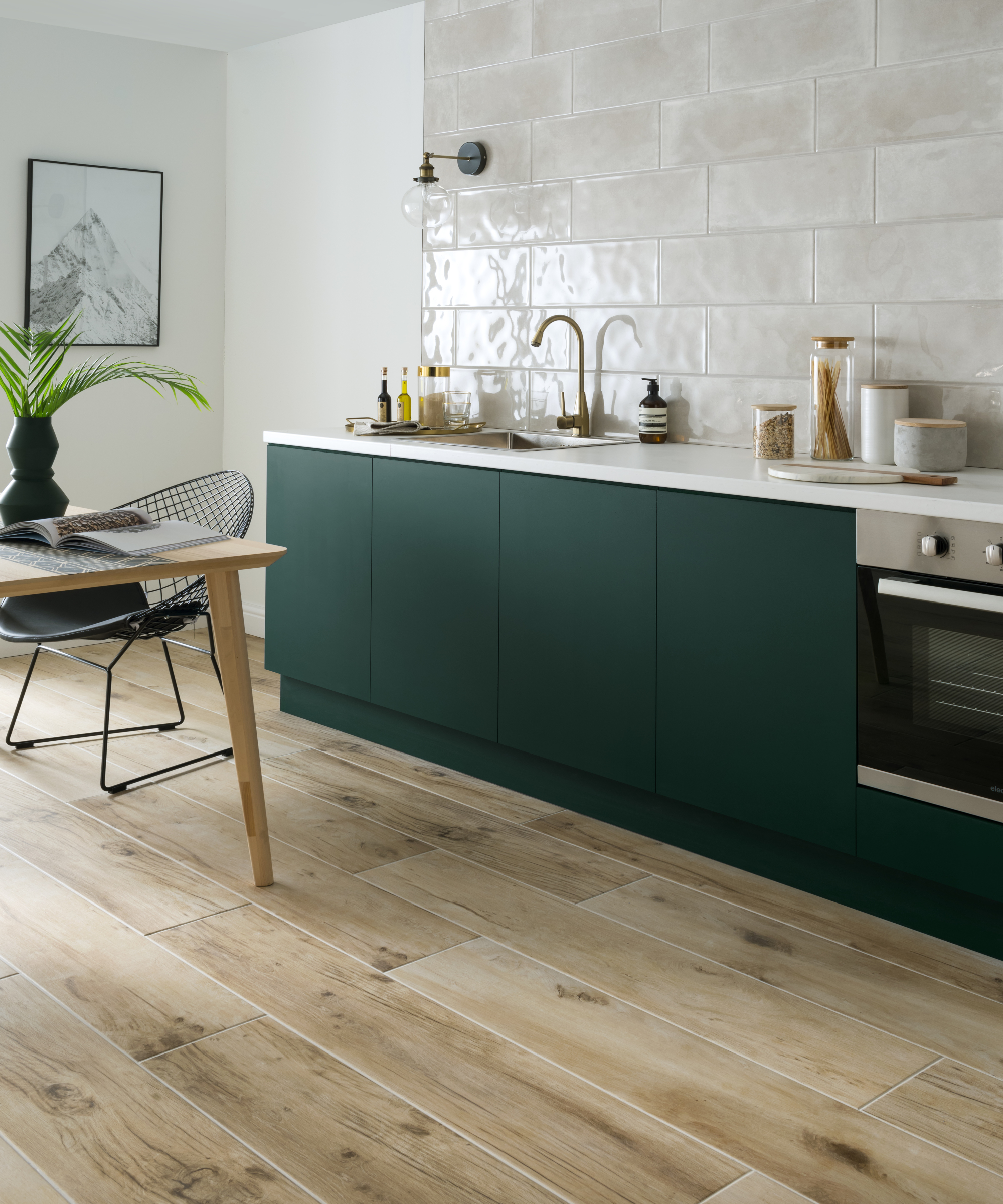
Perhaps you want that natural wood look but you're after something a bit slicker and safer in a moist environment like a kitchen or bathroom? Wood-effect kitchen tile ideas could be the solution.
'Wood effect tiles have grown in popularity in recent years and bring warmth, color, and durability to any space with a wide array of styles and texture available,' says Harriet Goodacre, Brand Communications Manager and Tile Consultant at Topps Tiles. 'In addition to their versatility in style, wood effect tiles are perfect for hardworking areas of the home and are a lot more durable than their real wood counterparts. They’re incredibly easy to look after and clean, needing minimal effort and upkeep to ensure they stay looking in great condition.'
'If you’re working with a small kitchen, we advise going for a simple grain in light shades to ensure it doesn’t feel too claustrophobic. Wood effect tiles in an oak shade and laid in a traditional plank-style work particularly well in kitchen, providing some natural warmth and an airy feeling to the space. If you have a bigger space to play with then consider experimenting with the layout or pattern of your wood effect tiles. Parquet or herringbone laying patterns are a great way to add some flair and style to your home and can make a room that’s relatively minimalist come alive with some added drama and color.'
Jason Cherrington, Director at Lapicida adds; 'very much on-trend, wood-effect porcelain is a fantastic alternative as it offers all the authenticity of genuine wood but all the practicalities and ease of porcelain. Easy to maintain, thinner, more stable and more durable than real timber, it is an ideal surface for high traffic areas such as kitchens.'
10. On a budget? Get an authentic look with wood-effect laminate
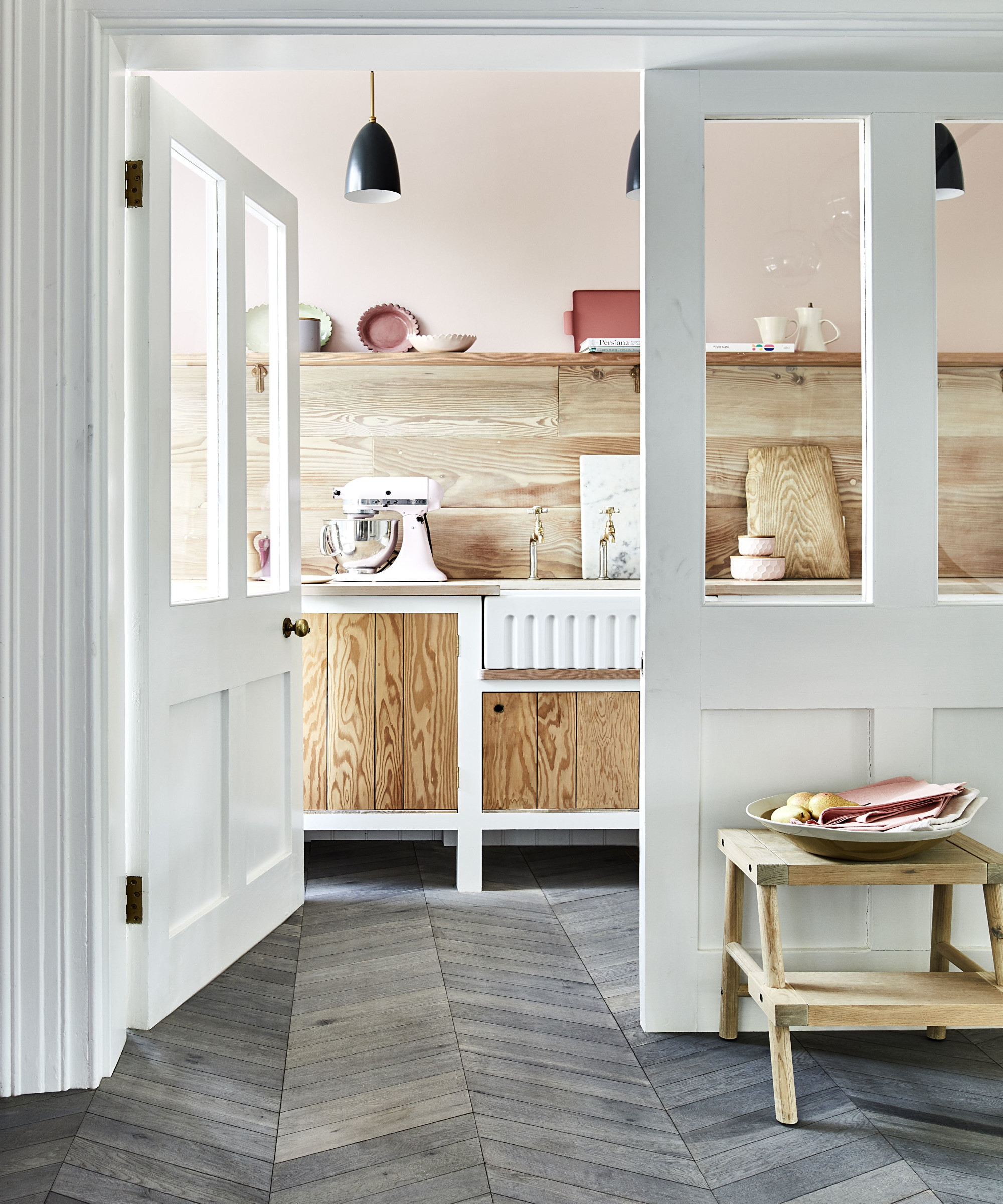
If you're after something a bit more cost-effective that real wood or wood-effect tiles then laminate is ideal. 'Wood is a particularly popular choice in laminate as the grain is very detailed; effectively emulating real hardwood flooring whilst being low maintenance and lower cost,' explains David Snazel, Buyer at Carpetright.
'In addition to tile-style laminates, such as chevrons, wood designs on laminate offer the opportunity to add an eye-catching design to the floor without the hassle of intricate measuring and laying out.'
What is the best wood for a kitchen floor?
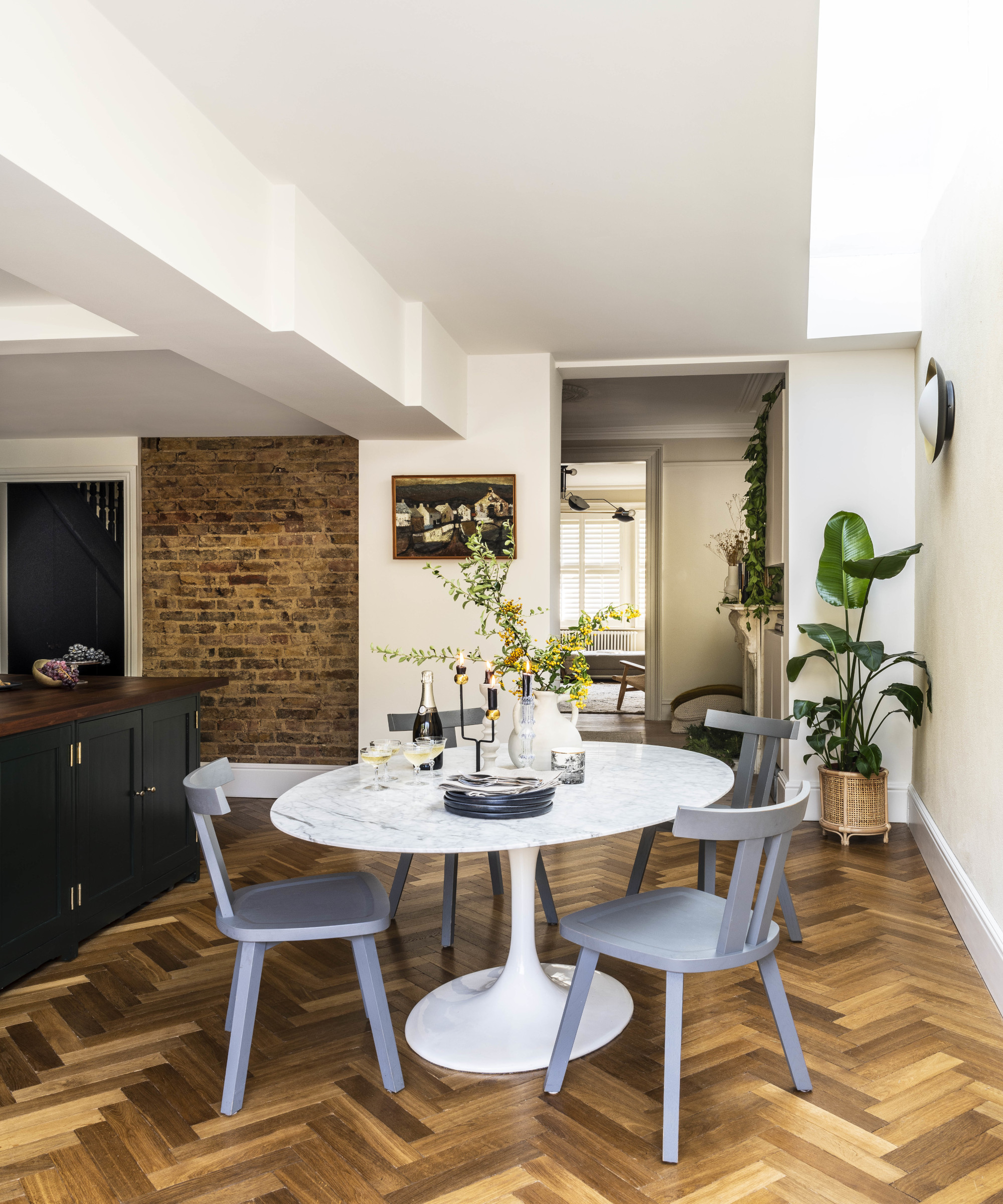
The best wood floor for a kitchen is down to personal taste, budget and what level of practicality you're after. Hardwood such as oak, maple, or cherry, as opposed to a softwood, will have greater longevity but it's more expensive.
Engineered wood is a more cost-effective option and is better suited to high-spill areas like bathrooms and kitchens, while wood-effect tiles and laminate have the benefit of looking like wood while being far more water-resistant. They're not as lovely and warm underfoot though! If you're after something sustainable, then reclaimed flooring is the best bet for you, but be aware it's more expensive than solid wood.
Darwyn Ker, Managing Director of Woodpecker Flooring, says; 'wood naturally expands and contracts as heat and moisture levels rise and fall. In most rooms of the home, these changes are small but heat and steam from cooking can cause larger fluctuations in the kitchen, which is why choosing the right type of wood flooring and keeping the kitchen well ventilated, especially when cooking, is key.'
Is wood flooring good for kitchen?
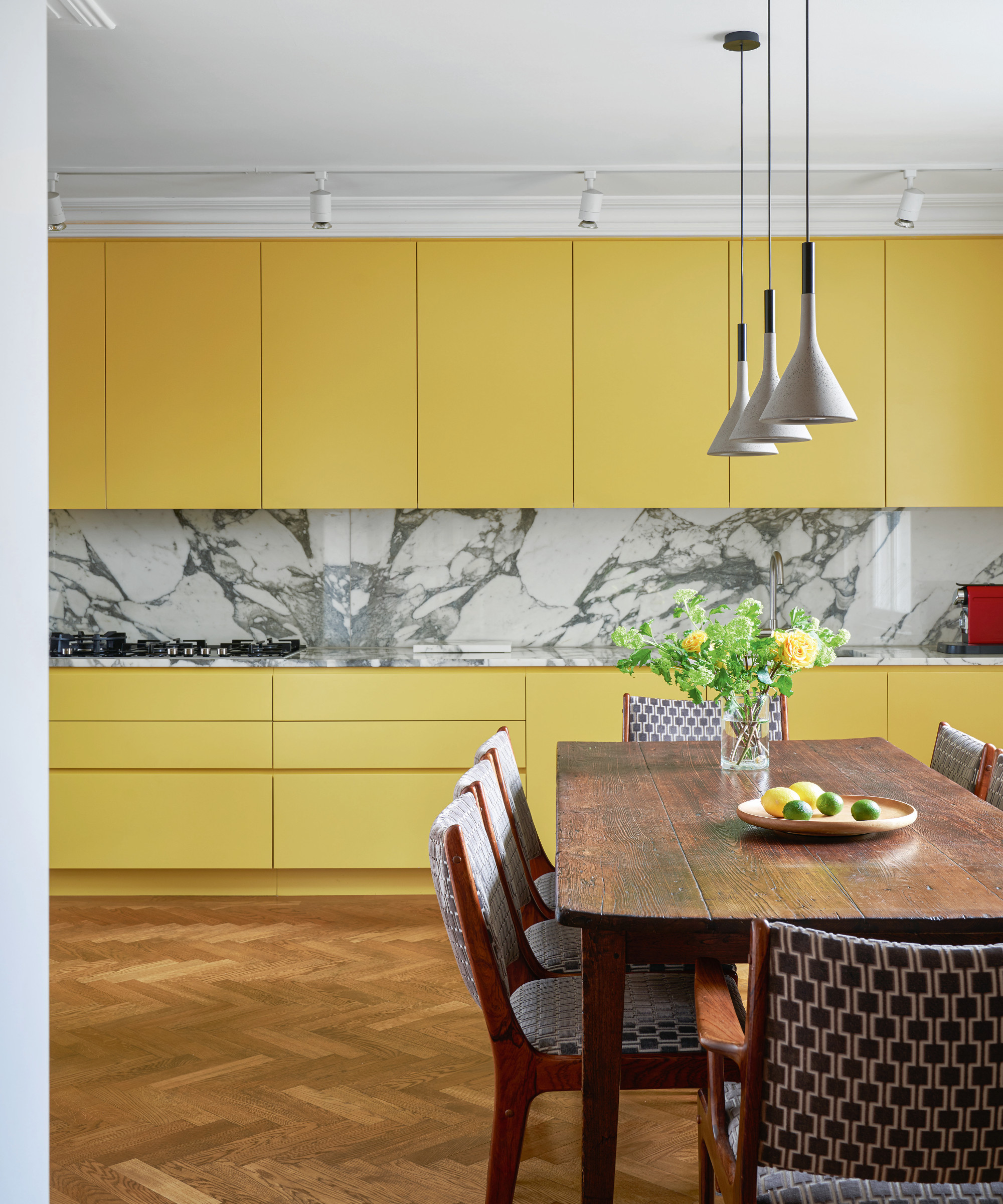
Hardwood flooring looks beautiful and is more sustainable than other wood alternatives. Plus, it comes in a variety of natural colors and it doesn't absorb dust or debris, making it easy to clean and maintain.
However, it can warp over time in high moisture areas and is easily bumped and bruised in high traffic areas, so if you're not after a character floor that's full of knocks, engineered, laminate, or kitchen floor tile ideas might be more suitable.
What flooring is best for kitchen?
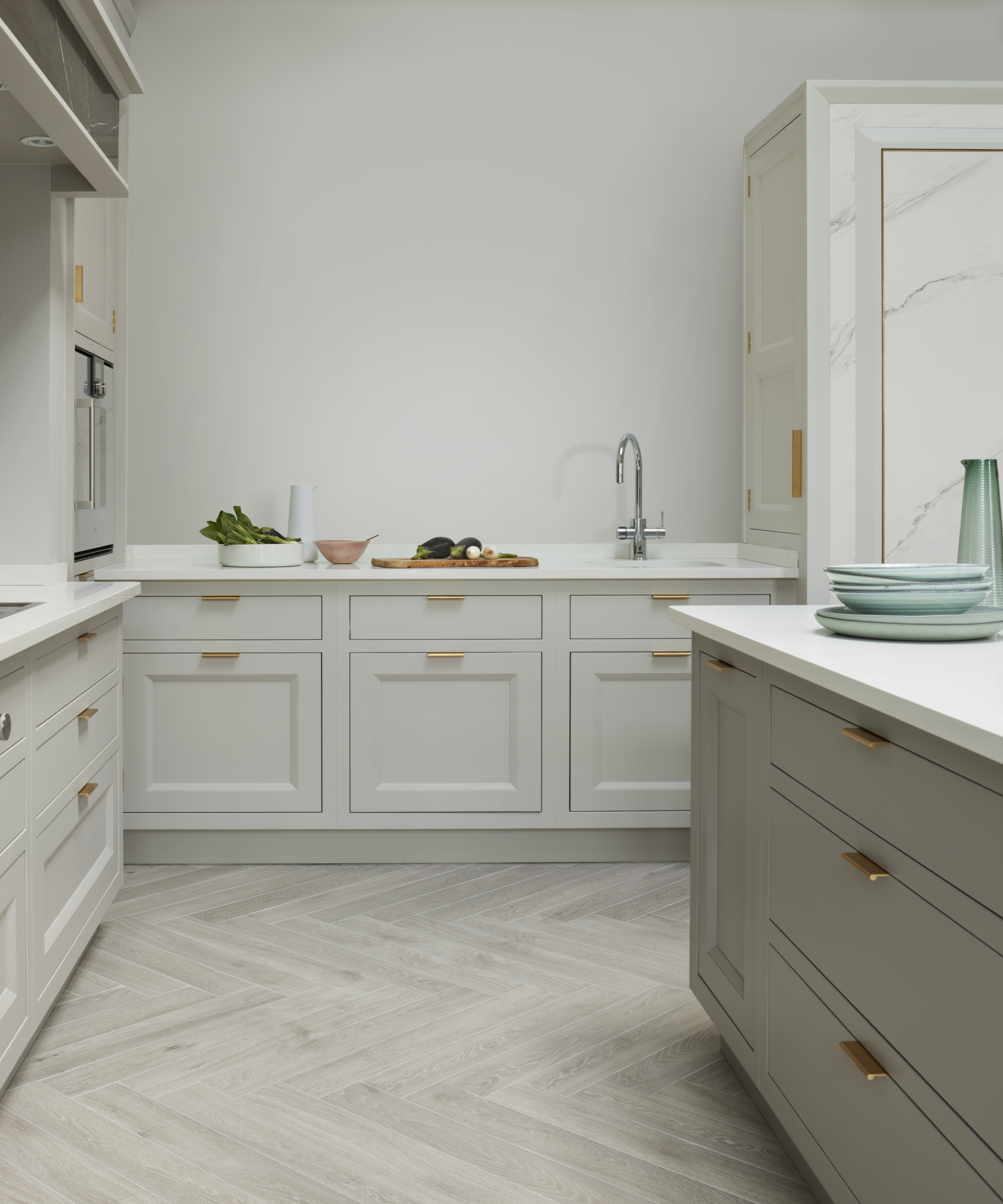
Wood kitchen flooring is an excellent choice if you're after a sustainable option that will look gorgeous, natural, and full of character for years to come. It's definitely an investment as it can cost a lot, especially reclaimed options.
However, many people love a tiled floor in a kitchen due to the frequent exposure to water. Ceramic, porcelain, and stone tiles with a wood-effect pattern are popular alternatives to wood flooring ideas as they can come in many sizes and colors and can be laid out in a variety of patterns to suit just about any design theme.
'The kitchen is the heart of the home, and the place where many of us spend the most time. For this reason, it’s important to choose a kitchen floor that can withstand heavy traffic and that isn’t going to get easily marked or damaged,' says Richard Moore, Design Director at Martin Moore who believes that wood-effect tiles are the best flooring for kitchens. 'Wood effect porcelain tiles are a great flooring solution, as they combine the look of real wood with the performance of porcelain, offering both style and substance.'
Be The First To Know
The Livingetc newsletters are your inside source for what’s shaping interiors now - and what’s next. Discover trend forecasts, smart style ideas, and curated shopping inspiration that brings design to life. Subscribe today and stay ahead of the curve.

As the Houses Editor on Livingetc, Rachel has been obsessed with property ever since she was a kid. With a diploma in interior design and more than a decade working on interior magazines under her belt, she feels very at home sourcing the best contemporary houses the world has to offer for Livingetc. It's not just the day job either, she admits she's spent a scary amount of her own time researching schemes for her own renovations - scrolling Instagram, stalking Rightmove and Modern House, flicking through magazines and snooping in other peoples' windows - so she really does live and breathe houses on a daily, if not hourly, basis. Before Livingetc, Rachel had a stint finding homes for Ikea Family magazine where she was lucky enough to gallivant around the world on shoots meeting and interviewing interesting people, all with a very keen eye for blending high-end design with everyday items from Ikea. It inspired her to not be afraid of mixing new and old, expensive and affordable, vintage and modern and so Rachel's current Victorian terrace in north London is very much an updated, contemporary take on a period property; think open-plan modern kitchen with concrete floors, feature fireplaces and her grandmother’s paintings on the walls. Rachel is currently crushing on reeded glass, large gingham prints, squishy curved furniture; like Buchanan Studio’s Studio chair, and vintage wall sconces; she especially adores Retrouvius for sourcing antique finds and feels inspired by Lonika Chande, Beata Heuman and Matilda Goad and already can’t wait to start planning her next home, wherever that might be.
-
 Burl Wood Decor Is 2025’s Most Coveted Comeback — Here’s How to Get the Storied Swirls for Less
Burl Wood Decor Is 2025’s Most Coveted Comeback — Here’s How to Get the Storied Swirls for LessIrregularity is the ultimate luxury, but you don’t need an antiques dealer to find it
By Julia Demer Published
-
 5 Garden Features That Instantly Add Value to Your Home — While Making Your Outdoor Space More Practical, too
5 Garden Features That Instantly Add Value to Your Home — While Making Your Outdoor Space More Practical, tooGet to know all the expert tips and tricks for making your backyard a standout selling point for your home.
By Maya Glantz Published